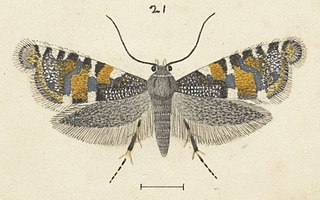
Dodona egeon, the orange Punch, is a small but striking butterfly found in the Indomalayan realm - in Mussoorie to Assam, Burma (nominate) and Peninsular Malaya that belongs to the family Riodinidae.

Curetis bulis, the bright sunbeam, is a species of butterfly belonging to the lycaenid family. It is found in Asia.

The Indian fritillary is a species of butterfly of the nymphalid or brush-footed family. It is usually found from south and southeast Asia to Australia.

Hippotion celerio, the vine hawk-moth or silver-striped hawk-moth, is a moth of the family Sphingidae. It was described by Carl Linnaeus in his 1758 10th edition of Systema Naturae.

Glyphipterix simpliciella, the cocksfoot moth, is a species of moth of the family Glyphipterigidae.

Glyphipterix schoenicolella is a species of moth of the family Glyphipterigidae. It is found in the Netherlands, Belgium, Bulgaria, Denmark, Estonia, France, Greece, Ireland, Italy, Latvia, Norway, Austria, Portugal, Russia, Slovakia, Spain, the Czech Republic, the United Kingdom and Sweden.

Grapholita jungiella is a moth of the family Tortricidae. It is found in most of Europe, east to the Near East and the eastern part of the Palearctic realm.

Cosmopterix clemensella is a moth of the family Cosmopterigidae. It is known from Canada and the United States.

Cosmopterix etmylaurae is a moth of the family Cosmopterigidae. It is known from Costa Rica.

Cosmopterix gemmiferella is a moth of the family Cosmopterigidae. It is known from the United States and Canada (Ontario).

Cosmopterix lespedezae is a moth of the family Cosmopterigidae. It is known from the United States.

Cosmopterix nitens is a moth of the family Cosmopterigidae. It is known from the United States, where it is found from coastal South Carolina to south-western Texas. It is also established in Michigan.

Cosmopterix pulchrimella, the beautiful cosmopterix moth, is a moth of the family Cosmopterigidae. It is known from the United States and Canada. It is also present in the Palearctic realm, where it is known from the Mediterranean Basin, from Portugal to the western Transcaucasus, north to Switzerland and Hungary. It has also been recorded from the Azores, the Canary Islands and Madeira. It has recently been found in southern England.

Cosmopterix orichalcea is a moth of the family Cosmopterigidae. It is known from most of Europe east to Japan.

Glyphipterix haworthana, Haworth's glyphipterid moth, is a moth of the family Glyphipterigidae. It is found in most of Europe, as well as North America.

Glyphipterix forsterella is a moth of the family Glyphipterigidae. It is found from most of Europe, east to Japan.

Glyphipterix acronoma is a species of sedge moth in the genus Glyphipterix. It is endemic to New Zealand and is found in the North and South Islands. It's preferred habitat is open fields on mountain sides and adults are on the wing in December and January.

Glyphipterix tungella is a species of sedge moth in the genus Glyphipterix. It is endemic to New Zealand and is found throughout the country. Larvae mine the leaves of small sedges. Adults of this species are day flying and inhabit sheltered scrub or grassy areas and forest clearings.

Glyphipterix euastera is a species of sedge moth in the genus Glyphipterix. It is endemic to New Zealand. This species is classified as "At Risk, Naturally Uncommon" by the Department of Conservation.
Helcystogramma gypsaspis is a moth in the family Gelechiidae. It was described by Edward Meyrick in 1921. It is found on Java in Indonesia.













